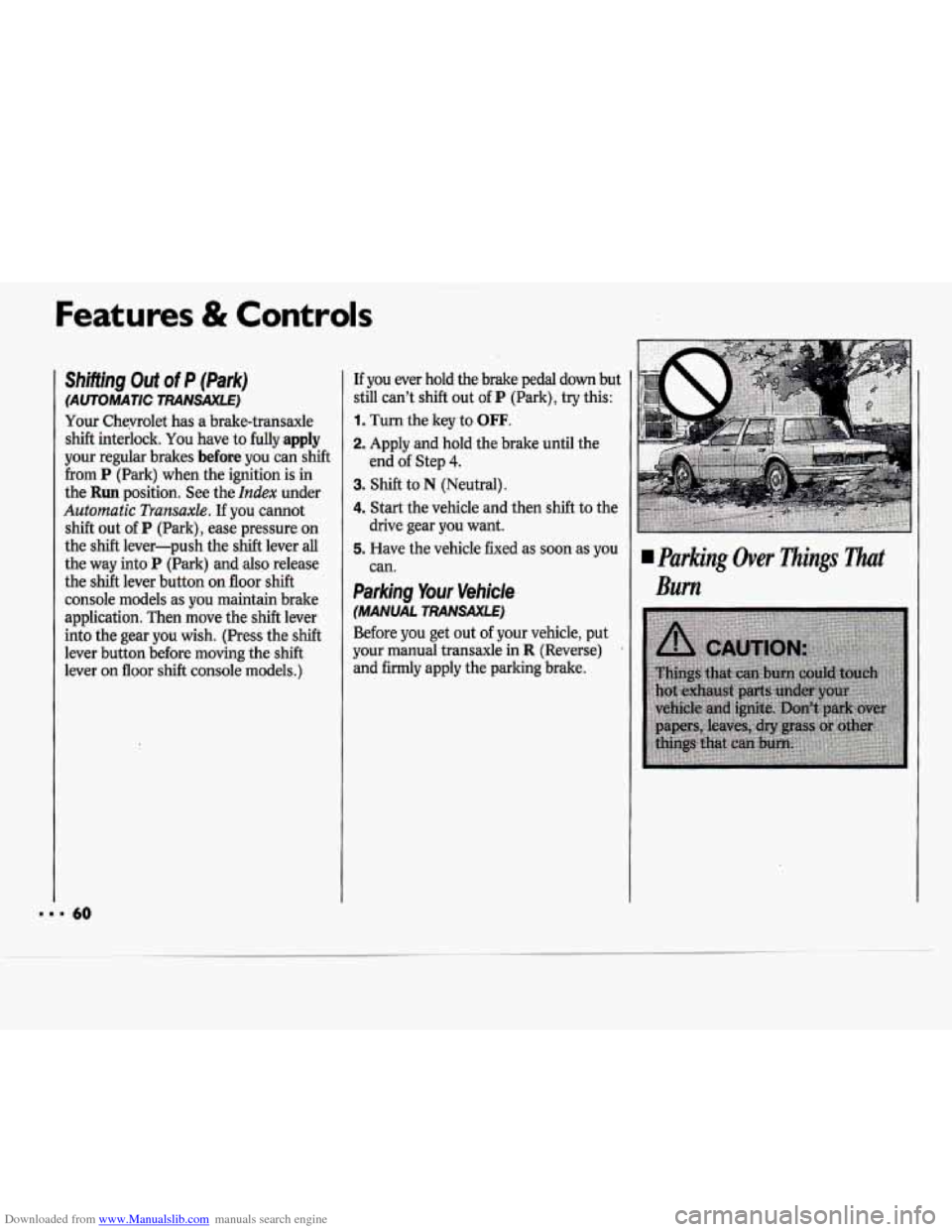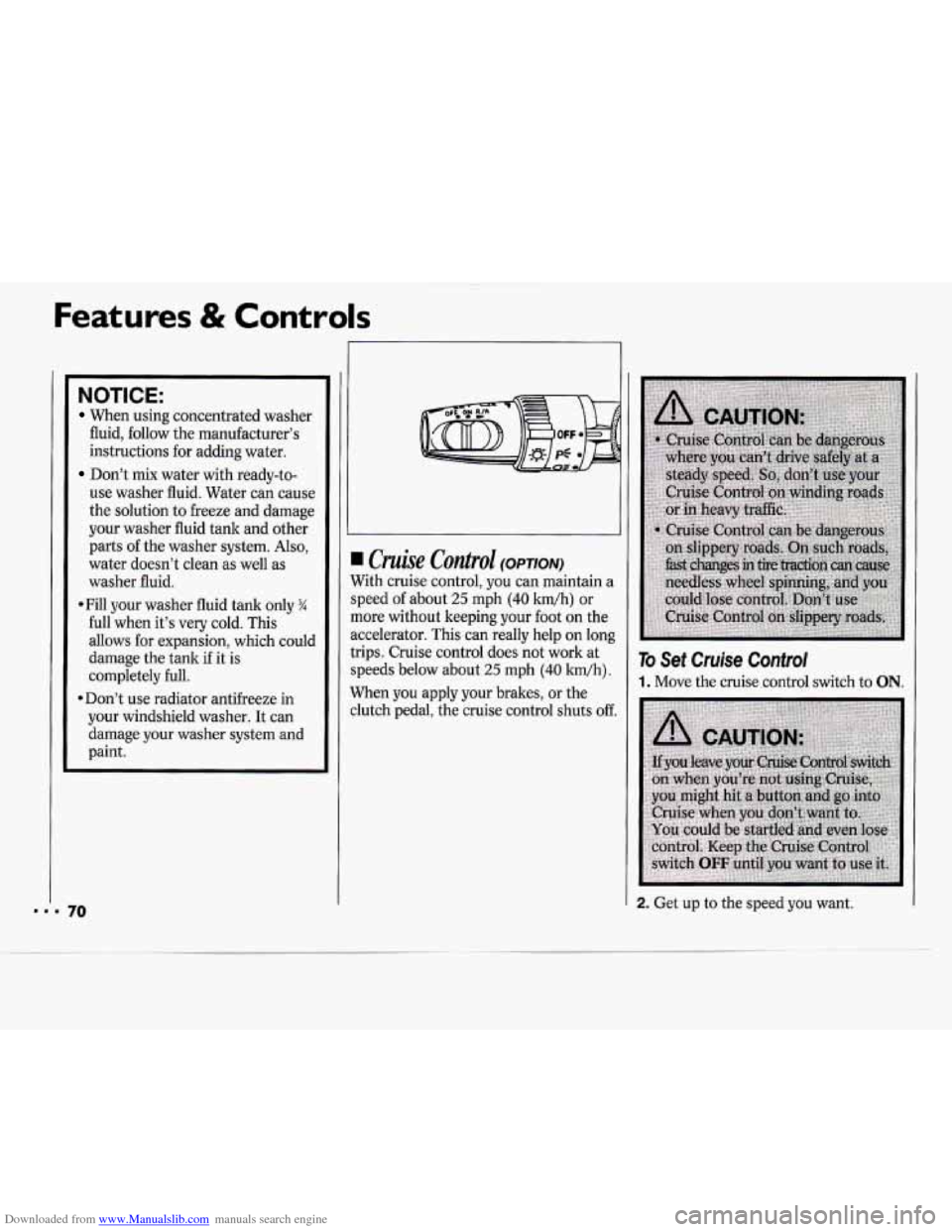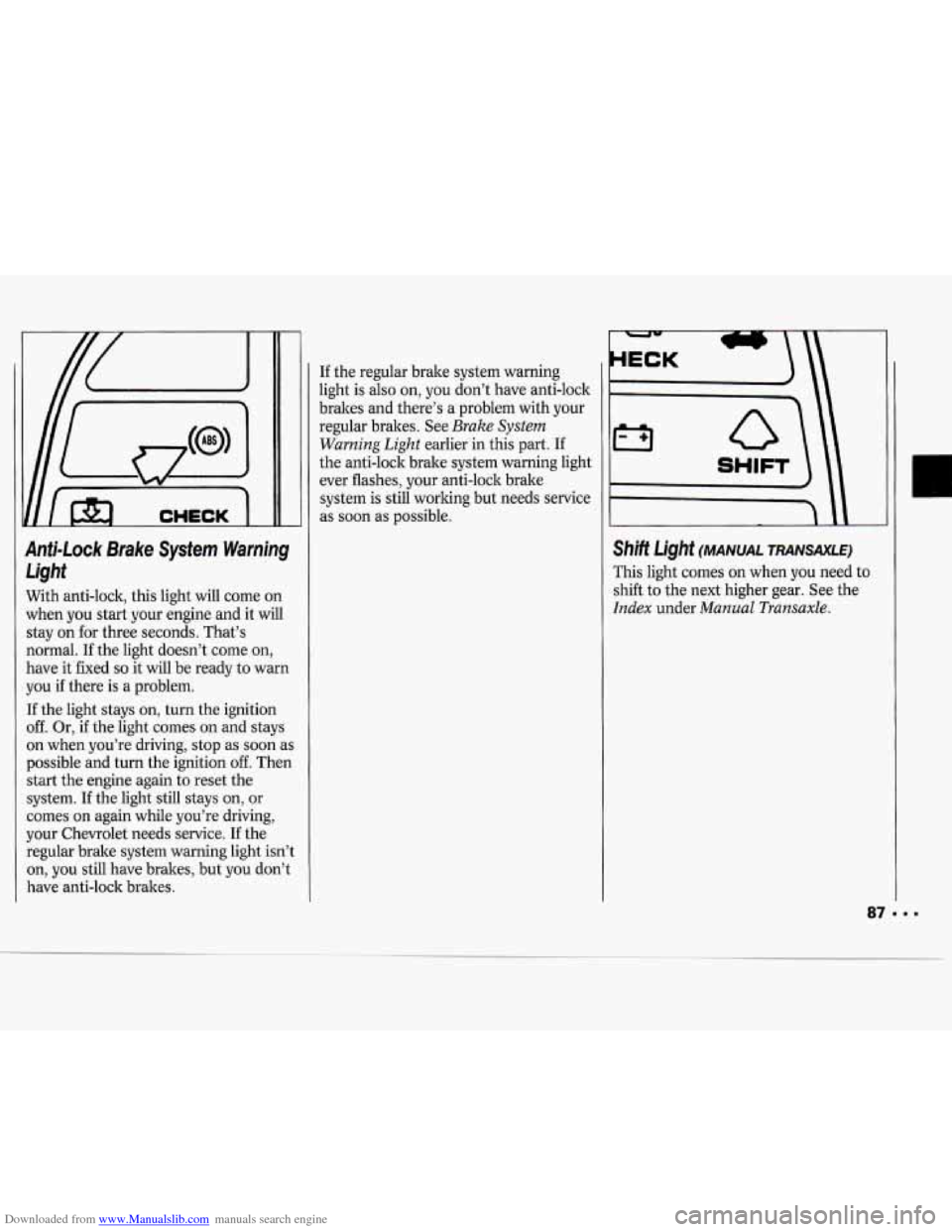Page 11 of 243
Downloaded from www.Manualslib.com manuals search engine How to Use this Manual
These symbols are on some of your
controls:
Windshield Wipers
Windshield Washer
Windshield Defroster
Rear Window Defogger
Ventilating Fan
These symbols are used on warning and
indicator
lights:
Engine Coolant
Temperature
Battery Charging
System
Fuel
Engine Oil Pressure
Brake
Anti-Lock Brakes
p3
Here are some other symbols you may
see:
Fuse
Trunk Release
Lighter
Horn
Speaker
Hood Release
Page 55 of 243
Downloaded from www.Manualslib.com manuals search engine Features & Controls
Ensure the shift lever is fully in P
(Park) range before starting the engine.
Your Chevrolet has a brake-transaxle
shift interlock.
You have to fully apply
your regular brakes before you can shift
from
P (Park) when the ignition ley is
in the
Run position. If you cannot shift
out of
P (Park), ease pressure on the
shift lever-push the shift lever all the
way into
P (Park) and also release the
shift lever button as you maintain brake
application. Then move the shift lever
into the gear you
wish. See the Index
under Shifting Out of P (Park).
Reverse
R (Reverse): Use this gear to back up.
NOTICE:
Shifting to R (Reverse) while your
vehicle is moving forward could
damage your transaxle. Shift to
R
only after your vehicle has stopped.
To rock your vehicle back and forth to
get out
of snow, ice or sand without
damaging your transaxle, see the
Index
under If You’re Stuck: In Sand, Mud,
Ice or Snow.
54
Page 56 of 243
Downloaded from www.Manualslib.com manuals search engine Neutral
N (Neutral): In this position, your
engine doesn’t connect with the wheel:
To restart when you’re already moving,
use
N (Neutral) only. Also, use N wher
your vehicle is being towed.
I
NOTICE:
Damage to your transaxle caused
by shifting out
of P (Park) or N
(Neutral) with the engine racing
isn’t covered by your warranty.
Forward Gears
D (Drive): This position is for normal
driving.
2 (Second Gear): This position gives
you more power but lower fuel economy
You can use 2 on hills. It can help contro
your speed as you
go down steep
mountain roads, but then you would
also want to use your brakes off and on
NOTICE:
..
Don’t drive in 2 (Second Gear) for
more than
5 miles (8 km), or at
speeds over
55 mph (88 km/h), or
you can damage your transaxle.
Use
D as much as possible.
Don’t
shift into 2 unless you are
going slower
than 65 mph (105 km/h),
or you can damage your engine.
I
L
55===
Page 57 of 243

Downloaded from www.Manualslib.com manuals search engine Features & Controls
1 (First Gear): This position gives you
even more power (but lower fuel
economy) than
2. You can use it on
very steep hills, or in deep snow or
mud.
If the selector lever is put in 1, the
transaxle won’t shift into first gear until
the vehicle is going slowly enough.
NOTICE:
If your front wheels can’t rotate,
don’t try to drive. This might
happen if you were stuck in very
deep sand or mud or were up
against
a solid object. You could
damage your transaxle.
Also, if you stop when going uphill,
don’t hold your vehicle there with
only the accelerator pedal. This
could overheat and damage the
transaxle. Use your brakes or shift
into
P (Park) to hold your vehicle
in position on a hill.
3.1L V6 Engine:
Maximum engine speed is limited to
protect driveline components from
improper operation.
Manual Transale
There are seven different positions:
N Neutral
1 First Gear
2 Second Gear
3 Third Gear
4 Fourth Gear
5 Fifth Gear
R Reverse
1 3 5
2 4 R
This is your shift pattern. Here’s how to
operate your transaxle:
1 (First Gear): Press the clutch pedal
and shift into
1. Then, slowly let up on
the clutch pedal as
you press the
accelerator pedal.
You can shift into
1 when you’re going
less than
20 mph (32 km/h) . If you’ve
come to a complete stop and it’s hard to
shift into
1, put the shift lever in N
(Neutral) and let up on the clutch.
Press the clutch pedal back down. Then
shift into
1.
2
(Second Gear): Press the clutch pedal
as you let up on the accelerator pedal
and shift into
2. Then, slowly let up on
the clutch pedal as you press the
accelerator pedal.
Page 59 of 243
Downloaded from www.Manualslib.com manuals search engine Features & Controls
Parking Brake
The parking brake lever is located
between the bucket seats.
To Set the Parking Brake:
Hold the brake pedal down and pull up
on the parking brake lever.
If the ignition is on, the brake system
warning light will come
on.
J
To Release the Parking Brake:
Hold the brake pedal down. Pull the
parking brake lever up until you can
press the release button. Hold the
release button
in as you move the brake
lever all the way down.
NOTICE:
Driving with the parking brake on
can cause your rear brakes to
overheat.
You may have to replace
them, and you could also damage
other parts
of your vehicle.
Shijling Into C( P JJ (Park)
(AUTOMATIC TRANSAXLE
MODELS ONLY)
1. Hold the brake pedal down with your
right foot and set the parking brake.
Page 61 of 243

Downloaded from www.Manualslib.com manuals search engine Features & Controls
Shifting Out of P (Park)
(AUTOMATIC TRANSAXLE)
Your Cheyrolet has a brake-transaxle
shift interlock. You have
to fully apply
your regular brakes before you can shift
from P (Park) when the ignition is in
the
Run position. See the Index under
Automatic Transaxb. If you cannot
shift out of P (Park), ease pressure on
the shift lever-push the shift lever all
the way into
P (Park) and also release
the shift lever button on floor shift
console models as you maintain brake
application. Then move the shift lever
into the gear you wish. (Press the
shift
lever button before moving the shift
lever on floor shift console models.)
If you ever hold the brake pedal down but
still can’t shift out
of P (Park), try this:
1. Turn the key to OFF.
2. Apply and hold the brake until the
3. Shift to
N (Neutral).
4. Start the vehicle and then shift to the
drive gear you want.
5. Have the vehicle fixed as soon as you
end
of Step 4.
Can.
Parking Your Vehicle
(MANUAL
TRANSAXLE)
Before you get out of your vehicle, put
your manual transaxle in
R (Reverse) .
and firmly apply the parking brake.
Parking Over Things That
Burn
Page 71 of 243

Downloaded from www.Manualslib.com manuals search engine Features & Controls
NOTICE:
When using concentrated washer
fluid, follow the manufacturer’s
instructions for adding water.
Don’t mix water with ready-to-
use washer fluid. Water can cause
the solution
to freeze and damage
your washer fluid tank and other
parts
of the washer system. Also,
water doesn’t clean as well as
washer fluid.
*Fill your washer fluid tank only
%
full when it’s very cold. This
allows for expansion, which could
damage the tank if it is
completely
full.
*Don’t use radiator antifreeze in
your windshield washer. It can
damage your washer system and
paint.
&&? co&ol (OPTION)
With cruise control, you can maintain a
speed of about
25 mph (40 km/h) or
more without keeping your foot on the
accelerator. This can really help
on long
trips. Cruise control does not work at
speeds below about
25 mph (40 km/h).
When you apply your brakes, or the
clutch pedal, the cruise control shuts
off.
To Set Cruise Control
1. Move the cruise control switch to ON.
2. Get up to the speed you want.
Page 88 of 243

Downloaded from www.Manualslib.com manuals search engine Anti-Lock Brake System Warning Light
With anti-lock, this light will come on
when you start your engine and it will
stay on for three seconds. That’s
normal.
If the light doesn’t come on,
have it fixed
so it will be ready to warn
you if there is a problem.
If the light stays on, turn the ignition
off. Or, if the light comes on and stays
on when you’re driving, stop as soon
as
possible and turn the ignition off. Then
start the engine again to reset the
system. If the light still stays on, or
comes on again while you’re driving,
your Chevrolet needs service.
If the
regular brake system warning light isn’t
on,
you still have brakes, but you don’t
have anti-lock brakes. If
the regular brake system warning
light is also on, you don’t have anti-lock
brakes and there’s a problem with your
regular brakes. See
Brake System
Warning Light
earlier in this part. If
the anti-lock brake system warning light
ever flashes, your anti-lock brake
system is still working but needs service
as soon as possible.
I SHIFT
Shift Light (MANUAL TRANSAXLE)
This light comes on when you need to
shift to the next higher gear. See the
Index under Manual Transaxle.